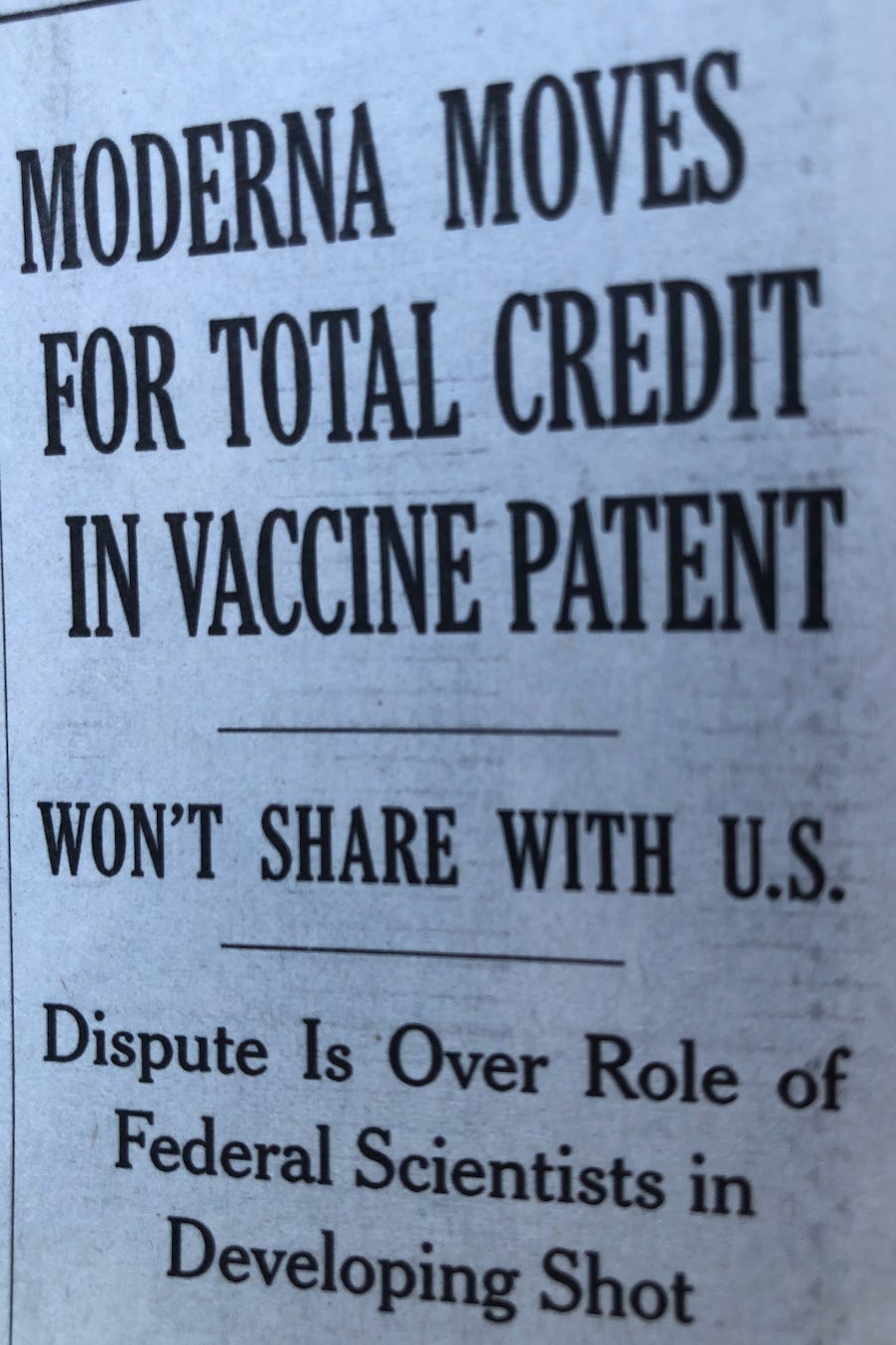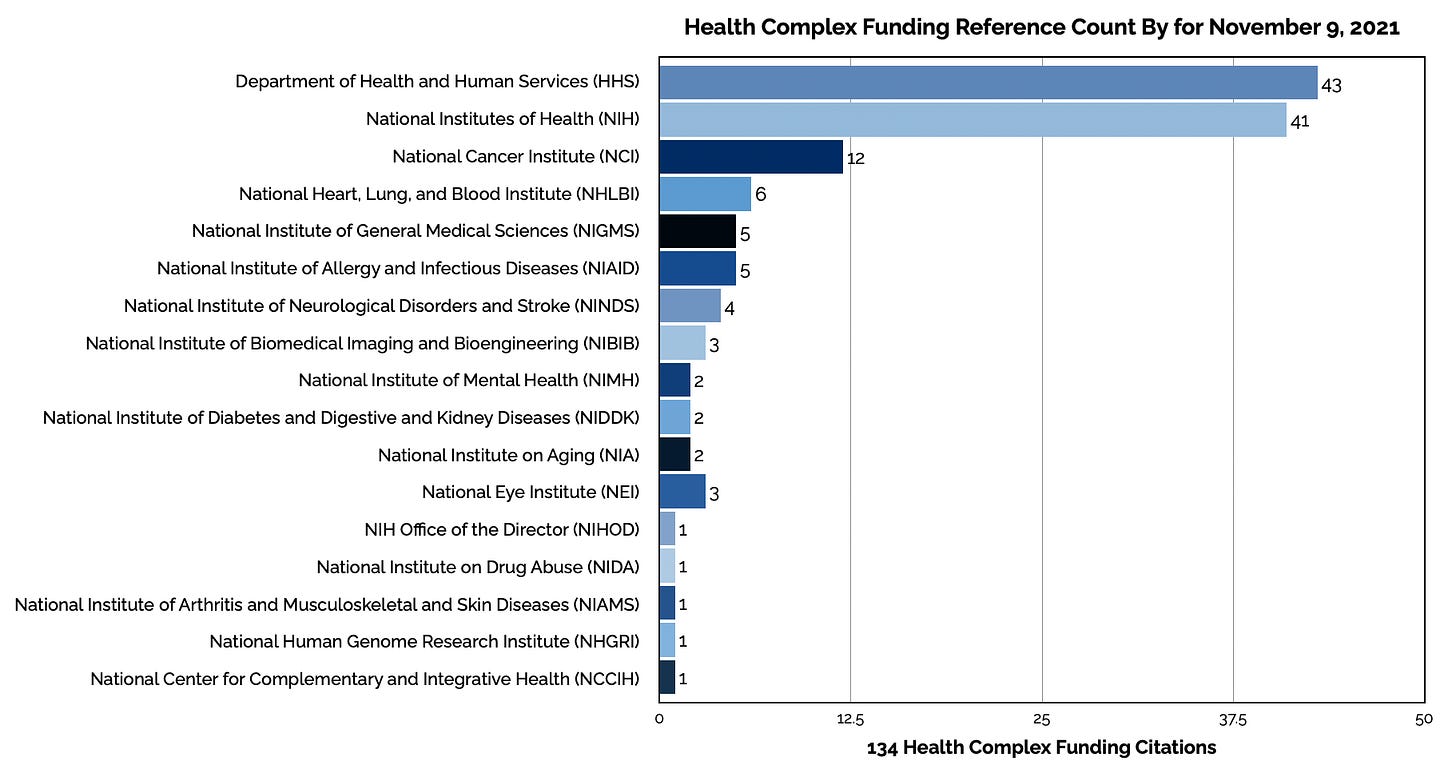Hello from FedInvent,
On Wednesday, the FedInvent team was surprised. The New York Times featured the word "patent" in a headline in the upper right corner, above the fold, and just below the masthead. Occasionally, you'll see the word "patent" buried deep in an article in the Tuesday Science section but on the front page?
The article is about the pending battle between the National Institutes of Health and Moderna on who gets credit for inventing the sequence that resulted in its highly effective coronavirus vaccine and one of the mRNA patent applications for Moderna's COVID-19 vaccination. The article explains the arcania of federal inventorship and how a patent can drive the economics of one of the most successful products in the history of pharmaceuticals. There is also a little bit of the usual misstatement on how the patent system works, but all things considered, a lot less than usual. The Moderna vaccination application was published on July 29, 2021 (20210228707). The application was filed on August 21, 2020.
You can read the article here. (If you can get through the paywall.). This battle will be epic.
Back to this Tuesday's taxpayer-funded patents. On Tuesday, the Patent Office granted 6,759 patents. One hundred twenty-eight (128) of those newly granted patents benefitted from taxpayer funding. Or at least federal funding that was acknowledged.
Here are a few highlights:
AKA The Fresh Prince — Iterative Aliases
The Dark Side of the Moon — Making Water In Space
Tiny Bubbles — Cataracts
Turn Back Time — Timelines For AI
And The Numbers
AKA The Fresh Prince
We're always suckers for pop culture references in the body of a patent. It helps make reading patents more tolerable. IBM patent 11170010, "Methods and Systems for Iterative Alias Extraction," uses the Fresh Prince to explain issues related to finding and linking aliases in cognitive, natural language processing systems.
"…a user provides a query for "Will Smith." Conventional approaches may allow the system to identify "Willard Smith" and "Willard Carroll Smith II," along with "Will Smith," as references to the target identity (i.e., assuming those alternative names are included in the database that is utilized).
However, the system may not be able to identify "The Fresh Prince" as an alternative name for the target identity, even if the term "The Fresh Prince" is included in the corpus in such a way that indicates that it is sometimes used to refer to the target entity."
The IBM Watson team is responsible for the invention in this newly granted patent. IBM is a Bayh-Dole scofflaw. IBM is working for a government agency with an unfindable contract number. The patent discloses all the data sources that may be used to generate a cognitive profile for the user. The data sources may include any appropriate data sources associated with the user that are accessible by the system (perhaps with the permission or authorization of the user). Perhaps with permission???? The iterative alias extraction invention can dig through the digital life of their target. IBM highlights its sources:
Communication sessions and the content — phone calls, video calls, text messaging, emails, in-person/face-to-face conversations, etc.
A profile of or basic information about the user — job title, place of work, length of time at the current position, family role, etc.
A schedule or calendar — the items listed thereon, time frames, etc.
Projects — past, current, or future work-related projects.
Location — previous and current location and location relative to other users,
Social media activity — posts, reactions, comments, groups, etc.
Browsing history — web pages visited and online purchases.
This is the Open-source intelligence (OSINT) playbook data.
Most of the other social media OSINT and social media-focused patents we've unearthed are funded by the Army Research Office, the Air Force Office of Scientific Research (AFOSR), the Navy Office of Naval Research, and the Pacific Northwest National Lab.
We think Agent J, Will Smith's character from the movie Men In Black would have been a more appropriate pop culture reference here. Agent J was working for a secretive government agency.
You can find the rest of the week's Bayh-Dole scofflaws here.
The Dark Side of the Moon
Missions to the Moon have revealed evidence that certain regions on the Moon, including those permanently in shadow or near-permanently in shadow, contain substantial concentrations of water ice. The raw materials for making water, hydrogen, and oxygen in space may be on the dark side of the Moon.
Paragon Space Development Corporation's Patent 11168013, "In-Situ Resource Utilization-Derived Water Purification and Hydrogen and Oxygen Production." It is for producing purified water, hydrogen, and oxygen from contaminated water. The contaminated water may be derived from regolith-based resources on the Moon, Mars, near-Earth asteroids, or other destinations in outer space. (Regolith refers to a region of loose unconsolidated rock and dust that sits atop a layer of bedrock.). NASA funded this work.
Tiny Bubbles
A team of inventors from Caltech, University of California, San Francisco, and the Department of Veterans Affairs invented a new way to treat cataracts. US Patent 11166846, "Method for Eye Lense Removal Using Cavitating Microbubbles," describes how to use gas-filled microbeads applied into a lens capsule holding the cataract, and ultrasound energy is directed at the microbeads to induce cavitation. The cataract lens material fragments, while the lens capsule is preserved. Then, the fragmented lens material is aspirated, sucked out from the lens capsule. Cataract gone. Lens preserved.
Turn Back Time
Suppose you are in the intelligence business or law enforcement (or even the e-discovery business). In that case, the sequence and timing of events are critical to understanding what happened or is about to happen.
One of the challenges in artificial intelligence (and reading articles on the web) is figuring out when things happen and the order in which events occur. These are the temporal elements of a document. The temporal elements enable analysts to build a timeline. For example, when did some event happen, and what is the sequence of events around one particular event. Then integrate a wide range of timelines associated with people and places. The AI challenge is amplified when you add thousands and thousands of events and timelines.
Patent 11170303, "Systems and Methods for Evaluating Temporal Dependency Trees," is assigned to Florida International University. The inventors have developed a method for quantifying temporal indeterminacy of timelines (e.g., the global ordering of temporal graphs and Temporal Dependency Trees (TDTs).
Patents By The Numbers
On Tuesday, November 9, 2021, the Patent Office granted 6,759 patents. One hundred twenty-eight (128) of those newly granted patents benefitted from taxpayer funding.
Here are the numbers for these taxpayer-funded patents:
123 patents have Government Interest Statements.
28 have an applicant or an assignee that is a government agency.
The 128 patents have 149 department-level funding citations.
These patents are the work of 421 inventors.
The 399 American inventors come from 33 states.
The Big Three States:
California has 25 first-named inventors and 86 total inventors.
New York has 10 first-named inventors and 23 total inventors. Massachusetts has 9 first-named inventors and 28 total inventors.
22 foreign inventors come from 8 countries.
There are 74 patents (58%) where at least one assignee is a college or university, the HERD.
Federally Funded Research and Development Centers (FFRDCs) received 12 patents.
A federal department is one of the assignees on 11 patents.
4 patents have Y CPC classifications indicating that USPTO believes the invention may be useful in helping to mitigate the impact of climate change.
Patent Count by Department
Count By Technology Center
Here is this week's Tech Center breakdown. There is one Reexamination patent, RE048811, which is not reflected in the Technology Center count.
The Health Complex
The table below shows the Department of Health and Human Services funding citations for patents granted on November 9, 2021.
That's this week's FedInvent Patent update. Please explore the FedInvent Patents Report. There are many more interesting inventions than we could jam into a newsletter.
If you'd like to catch up on earlier FedInvent Reports, you can access the newsletters here on Substack. In addition, the reports are available on the FedInvent Links page.
We're running a little late on our analysis of Tuesday's patents. There was an appointment for a Moderna booster that took more time than planned. And then there are other issues with the internet not cooperating.
Thursday's FedInvent Patent Application Report will be out over the weekend.
FedInvent is a work in progress. Please reach out if you have questions or suggestions. You can reach us at info@wayfinder.digital.
If you aren't a paid subscriber yet, please consider subscribing. It will help us keep the lights on. You'll get your money's worth from the subscription.
Thanks for reading FedInvent. We're running a little late on our analysis of Tuesday's patents. There was an appointment for a Moderna booster that took more time than planned and knocked me out. And then there are other issues with the internet not cooperating. Thursday's FedInvent Patent Application Report will be out over the weekend.
We'll see you Thursday for the latest on taxpayer-funded patents, new patent applications, and the latest on the federal innovation ecosphere.
The FedInvent Team
About FedInvent
FedInvent tells the stories of inventors, investigators, and innovators. Wayfinder Digital's FedInvent Project follows the federal innovation ecosphere, taxpayer money, and the inventions it pays for.
Here's the playlist:
Turn Back Time by Cher
Tiny Bubbles by Don Ho
The Dark Side of the Moon by Pink Floyd
The Fresh Prince by DJ Jazz Jeff and The Fresh Prince (aka Will Smith








